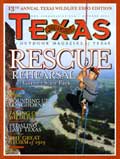
A Piece of Katy Prairie
A major ranch west of Houston has been preserved for both agriculture and wildlife.
By Bill Dawson
In 1992, birders, hunters and other conservationists formed a nonprofit land trust to save a significant portion of the dwindling Katy Prairie, a wildlife-rich agricultural area directly in the path of Houston’s westward suburban development. The area is one of North America’s most important wintering sites for migrating geese, ducks, shorebirds and other species.
This summer, the Katy Prairie Conservancy drew closer to its long-term goal of protecting 50,000 acres by obtaining a majority interest in the 6,500-acre Warren Ranch in northwestern Harris County.
The deal preserves a colorful part of Texas’ diminishing farming heritage, because as part of a land trust, the ranch will stay in agricultural production, raising cattle and peanuts as well as hay.
The Conservancy had been talking to the owners about the property for several years, but a deal came to fruition when a developer tried to buy the ranch. “We can save the property as open space and wetland habitat, and it will continue as a working ranch,” says Mary Anne Piacentini, executive director for the Katy Prairie Conservancy.
Jimmy Warren, great-grandson of the English settler who founded the ranch in the 19th century and also ran a famous Hockley restaurant serving game dinners, will be ranch manager. Land-use decisions will be made in concert with the Conservancy.
“To me and the Warrens, it means a lot,” Warren said of the transaction. “Now we can stay there as long as we want and not be driven off by development. Our partners (the Katy Prairie Conservancy) want the same thing we do — to preserve it as ranch land.”
Developers have bought other ranches in the area. Part of the nearby Josey Ranch has become a golf course community. Along with the neighboring Longenbaugh Ranch, the remainder of the Josey Ranch was acquired last year by a development company, which announced that the combined 8,300 acres would become the site of 17,000 homes.
With its controlling interest in the property obtained this year, the Katy Prairie Conservancy has now acquired — or been able to protect by other means, such as conservation easements — about 17,000 acres on the Katy Prairie.
The long-term goal to preserve 50,000 acres was adopted from a Texas Parks and Wildlife Department calculation in the early 1980s, says Piacentini. It is the area needed to maintain the prairie ecosystem and its more than 300 species. David Lobpries, the wetlands and waterfowl biologist for TPWD who made that acreage estimate, said it was based on what is needed to maintain the Katy Prairie’s “historical wetland habitat and historical goose use” — the minimum requirement for a population of 100,000 geese, plus ducks, shorebirds and other species.
TPWD has supported efforts to protect habitat on the Katy Prairie for years, and opposed the city of Houston’s now-abandoned plan for a new airport there in the 1980s. The agency also co-sponsored a seminal conference on the Katy Prairie in 1994, at which conservationists and business representatives agreed conservation should occur as urbanization proceeds in the area.
The Warren Ranch is already the site of birding and hunting, and the Conservancy has been looking at ways to enhance those activities. Warren Lake, which is a stop on TPWD’s Great Texas Coastal Birding Trail, now can only be viewed from a road. The Conservancy is considering building birding blinds closer to the water, Piacentini said. Eventually, she said, the Conservancy would like to draw visitors to the ranch, perhaps through a birding center or other educational programs.
Warren believes the deal sets an example that could influence other projects in which agriculture and wildlife conservation are practiced together on the Katy Prairie.
“To a lot of farmers and ranchers,” he says, “it gives them the option of staying put on the land and benefiting from the dollars the Conservancy pays them for purchase or for an easement.”

